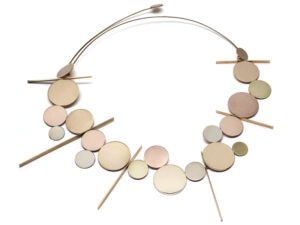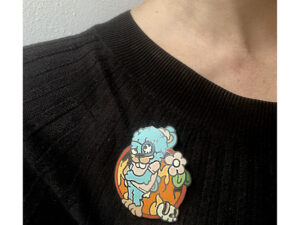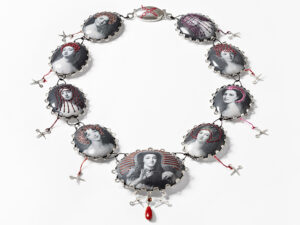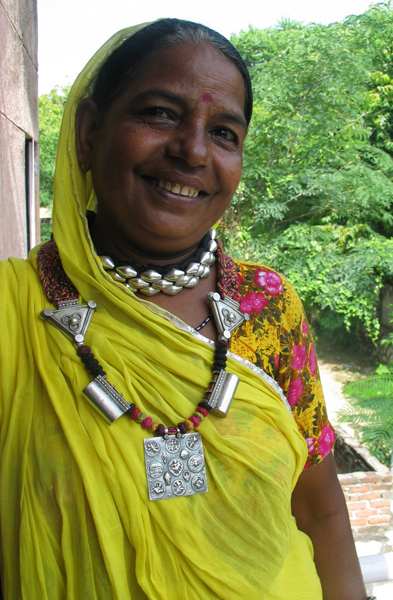
To us in the West, Sufism offers a kind of “Islam-lite.” The Qawwali music of Nusrat Fateh Ali Khan is a regular on the playlist of “world culture.” Western Sufism provides us with a mystical elevation but without any of the heavy religious obligations. But in more home-cooked performances, such as the ghazals of Abida Parveen, there is often a kind of audience contagion otherwise associated with rock-and-roll concerts. Compared with more formal religious rituals, in Sufism the audience identifies with mystical rapture that possesses the performer.
I mention Rumi because a network for contemporary jewelry has emerged in India that identifies with Sufism. Project Bawra takes its title from the word for mystic wonderer (also bawara in North India or baul in Bengal). It developed while Anvita Jain was studying at Cranbrook Academy of Art and participants include Iris Eichenberg and Rebekah Frank. According to the Project Bawra outline, their aim is to address the problem that “there is no prominent platform in India currently engaging in a dialogue on contemporary jewelry.” Project Bawra thus seeks to position contemporary jewelry in India as part of the fine arts, in which concept is more important than materials.
From an Indian point of view, the question is whether the development of a contemporary jewelry scene implies the adoption of a Western model. Some see this as attractive, demonstrating progress and offering international connections. Others would regret the loss of cultural distinctiveness and seek a clearly Indian contemporary jewelry. From the West, a new approach might be welcomed as a way of retaining global relevance, while others might dismiss this as a liberal conceit. All of these are true, but the cosmopolitan challenge seems the most creatively stimulating.
According to the default contemporary jewelry position, the work emerges from the hand of the artist, as it responds with skill, experimentation, and pleasure to the materials on the bench. Each work is original and circulates under the exclusive name of the artist. By contrast, the common setup for designer jewelers in India is more like Rumi in the bazaar. Rather than make the work themselves, these jewelers move among the artisans assembled in the workshop, cherry-picking skills for specific ends. This begs the question, is contemporary jewelry necessarily a solo production?
1. The Bricoleur
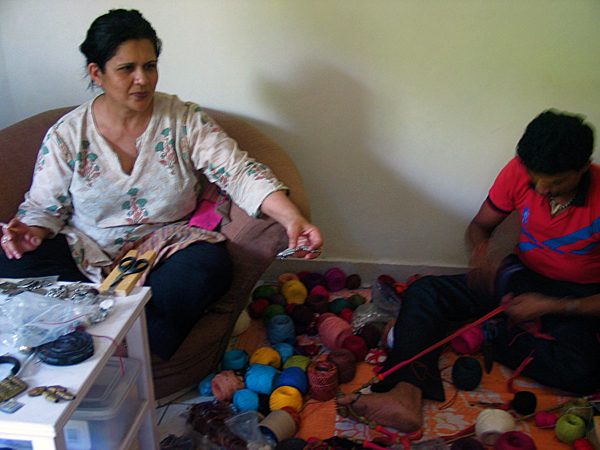
The second is relational aesthetics. As with the rise of participation in the visual arts, where the audience becomes the essential art material, so relational jewelry takes the bench out into the world and hands over its tools to the audience. Here, the work of contemporary jewelry is no longer read in terms of the artist’s experience but its capacity to draw out the meanings that others bring to it.
Of course, the studio model is more often observed in its breach than its adherence. It is common for jewelers to outsource elements of their bench, particularly specialist technologies such as electroplating and casting. There are even those, such as Suska Mackert, who rarely touch the bench, preferring to work on the concept exclusively. Though outsourcing is common, it is not something that adds new meaning to the work. It is more like a practical shortcut than a creative act in itself.

The possibilities that this model affords are demonstrated in the work of Sutopa Parrab, a well-travelled jeweler who has lived in India, Australia, and Canada. She spends most of her time in her own Jaipur workshop. Parrab specializes in tribal jewelry, bringing together different traditions in unique combinations. As she writes, “In jewelry-making, the skills are highly specialized and different artisans can do only particular kinds of work, therefore in a solo-studio model, artists are inevitably limited only to creating pieces for which they have the technical skills and know-how, which although very satisfying at some level, is also very limiting in scope!”[i] Parrab sources Banjara jewelry from Rajasthani gypsies with use of coin. In the villages of West Bengal, she acquires bronze dokra forms cast with the lost-wax method. And in Jaipur, she employs patwas, a caste of artisans whose skill is to weave with silver and gold thread. But Parrab is not completely aloof from production. She identifies herself as an artisan, stating “the hands-on approach gives me a better understanding of the properties and limitations of the materials I work with and the freedom to experiment.” Her contribution occurs at beginning and end of the production process—developing the design and polishing the final result.
Like many Western contemporary jewelers, Parrab operates as a bricoleur who makes novel combinations of found elements. She sources skills rather than materials. Her bench is the rich array of jewelry traditions found across the breadth of India.
Parrab identifies as an artist. “For me, making jewelry is nothing but another expression of art,” she says and bemoans the lack of opportunity to exhibit her work in Indian galleries. To artists like Parrab, contemporary jewelry offers a network that acknowledges her work for its artistic value as well as exposure to potential collectors. So, how would her work fit into the contemporary jewelry scene? Would it be the kind of work selected for Schmuck? I suspect not. Its traditional base is at odds with Munich’s modernist focus on originality, and the team production doesn’t fit the studio model. But there’s an alternative entry point that credits Parrab’s work with artisans for its relational value—how its production brings together makers who would otherwise never meet.[ii]
2. The Relational Jeweler
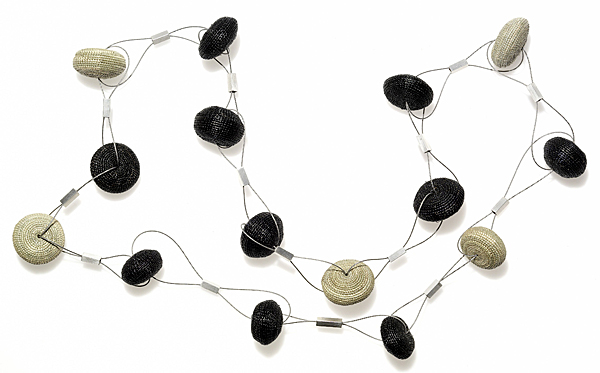
This follows a trajectory in visual arts emerging from relational aesthetics. In its early form, evident in the gallery dinners of Rirkrit Tiravanija, the relational artist aspired to open a democratic space where participants would be free to make new connections with each other. This was an anarchic strategy that presumed an alternative social space could merge immanently once hierarchies were cleared away—storm the Bastille and a natural social order will emerge unfettered by tradition. Despite its democratic aspirations, much relational art involves an internal art world conversation.

In the case of southern Asia, what bites politically is the “race to the bottom” of globalization, unmasked recently with tragedies such as the collapse of the Rona Plaza Bangladeshi textile factory on May 9, 2013. Has globalization masked the kind of exploitation of labor by capital once evident in working class cities such as Manchester and Pittsburgh? Should working with an illiterate villager in India be by definition an act of hidden exploitation? Could art imagine alternative relations between Western consumers and Asian producers?
3. The Cultural Interpreter
One step forward is to learn each other’s names. Sandra Bowkett is an Australian ceramicist who has spent recent years working and occasionally living with a caste of potters in Delhi. Her work has been driven by an appreciation of the simple form of spherical water vessels, mudka, which lost their market with the advent of bottled water. Bowkett has recently explored the possibility of developing ceramic jewelry, using the traditional skills of Anil Kumar, an Indian patwa, to create necklaces. In a more conventional matter, the Australian jeweler Minna Loft developed a relationship with Sitaben Chawda, an Indian bead craftsperson, while studying at the National Institute of Design in Ahmedabad. Chawda provided Loft with unique skills that the latter interprets and credits in her work. Both hybrid forms of jewelry carry an Indian artisanal lineage.

This has particular relevance for Aboriginal design. The organization Better World Arts takes Aboriginal paintings from a community near Uluru in central Australia and has them woven into rugs in the Kashmir. Last year, at the conference “Make it New Again” in Ahmedabad, the Aboriginal jewelry designer Jenuarrie sought out potential workshops that could help realize designs through lost-wax casting. Aboriginal culture does not have a tradition in metalsmithing, but many seek a form of commissioning that involves traditional skills rather than a more mechanical process as would be found in southern China. But, the obstacle emerged in the lack of confidence that such designs would not be copied without permission. As many of these designs are sacred, there is an onus on the jeweler to ensure that she has control over its use.
As an art form, contemporary jewelry is still in the process of developing its critical framework. The core idea at work in the studio model has been the critique of preciousness, particularly where jewelers can re-fashion nonprecious materials into body ornament. This sets the criteria—originality and craftsmanship—by which contemporary jewelry can be judged. But, it should be possible to gather at the bench other skills as well as materials. Is there scope for a more orchestral mode of creativity, where the artist coordinates the performances of others around the production of a cultural object?
From within, the contemporary jewelry field can seem riven by aesthetic, cultural, and personal differences, yet there are implicit ground rules on which the community is located. If it were a sport, it could be like golf: the artist comes as an autonomous unit following shared rules. But could the rules be changed for those who come as a team? This would entail including information on labels about who helped produce the work. This would add rather than subtract artist value from the work. The resulting work embodies the otherwise invisible relations between those who brought it to life. Otto Künzli’s wedding ring necklace demonstrates the power that a “back story” can have on the work. It doesn’t replace the material object, which should still command an independent aesthetic judgment. The game of contemporary jewelry continues. As well as transforming materials in unique ways, it can be a matter of metamorphosing traditions. The highway of contemporary jewelry remains the same, growing in traffic every year. We just add a lane for buses as well as cars. Next stop?
[i] Sutopa Parrab email correspondence with Kevin Murray, August 18, 2013
[ii] The Bangladeshi jeweler Amman Rashid would seem a more conventional candidate for contemporary jewelry. He sources materials from a broad range of cultural sources, including ink pots, trade beads, hookah parts, old brass seals, old cutlery, and old broken pottery pieces. Each work is unique and has its own name, such as Chiroshokha, Krishnobott, Kanchon, Protnotattik, and Aadibashi. There is no gallery for his work, and he has never heard of contemporary jewelry. He frames the work himself under the concept Aadi, which means “beginning” in Sanskrit. His work fits the studio model, and he is keen for international exposure. Can we imagine a Bangladeshi in Munich?
[iii] Roseanne Bartley’s Seeding the Cloud series is an important example of this. As “a civically formed necklace of residual plastic” (Roseanne Bartley email August 1, 2011), its product materializes the local knowledge of its collaborators, specifically their familiarity with the nooks where prospective materials might lie.


